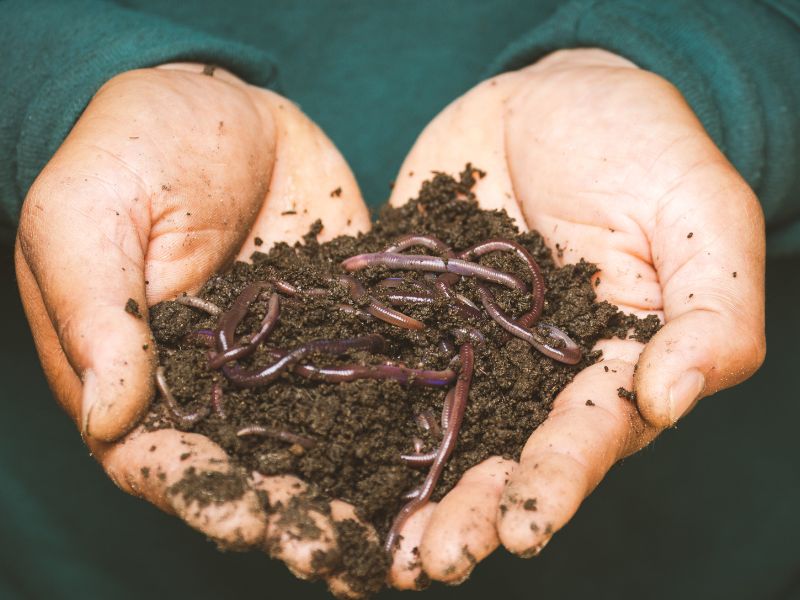Understanding the Benefits of Red Wiggler Composting: Just How This Efficient Method Changes Organic Waste Into Nutrient-Rich Soil Changes
Red Wiggler composting, utilizing the types Eisenia fetida, offers an engaging approach to organic waste administration, converting kitchen area scraps and lawn particles right into beneficial soil amendments. This method not only enhances soil fertility but likewise addresses pressing environmental issues, including garbage dump waste reduction and greenhouse gas discharges.
What Are Red Wigglers?
Red wigglers, clinically referred to as Eisenia fetida, are a varieties of earthworm that play a pivotal role in vermicomposting systems. These worms are characterized by their reddish-brown color, segmented bodies, and a distinct ability to thrive in organic-rich environments, making them perfect for composting applications - Red Wiggler Composting. Unlike their garden-dwelling counterparts, red wigglers choose to occupy the upper layers of soil, where rotting issue is bountiful
Usually determining between 3 to 4 inches in size, red wigglers have a high reproductive price, enabling them to increase quickly under optimal problems. They have a special gastrointestinal system that permits them to refine organic waste efficiently, transforming it right into nutrient-rich castings, which are highly beneficial for plant development.
Their tolerance to differing dampness degrees and temperature ranges even more enhances their utility in vermicomposting arrangements, making them a preferred choice amongst composting enthusiasts. In addition, red wigglers are cardiovascular microorganisms, which requires a well-aerated composting environment, making sure effective decay. Understanding the organic characteristics and actions of red wigglers is essential for maximizing their use in lasting waste management techniques.

Benefits of Vermicomposting
Using the power of vermicomposting deals a plethora of farming and environmental benefits. It considerably lowers natural waste in landfills, thus lessening methane exhausts, a powerful greenhouse gas. By diverting food scraps and yard waste to vermicomposting, we support a more sustainable waste administration system.
In addition, vermicomposting boosts dirt health. The castings produced by red wigglers are rich in vital nutrients, microorganisms, and enzymes, enhancing dirt framework and fertility. This nutrient-rich modification advertises durable plant development and boosts water retention, lowering the demand for chemical plant foods.
In addition, vermicomposting fosters biodiversity in the dirt ecological community. The intro of valuable microbes from worm spreadings help in condition reductions and nutrient cycling, producing a healthier environment for plants.
Economically, vermicomposting reduces the costs linked with chemical inputs and garbage disposal. Garden enthusiasts and farmers can cultivate premium produce at lower expenditures, adding to food protection and sustainability.
Just How to Begin Composting
Starting a composting endeavor can be a simple and rewarding procedure. This will aid maintain a well balanced temperature, critical for the composting procedure.
Gather organic materials such as cooking area scraps, yard waste, and shredded paper. Purpose for a balanced mix of 'environment-friendly' materials, high in nitrogen (e.g., fruit scraps, coffee premises), and 'brown' products, rich in carbon (e.g., dried fallen leaves, cardboard) pop over here A ratio of approximately 2:1 green to brown products is optimal.
Beginning layering your materials, making sure adequate air flow by transforming the pile consistently. This promotes cardiovascular disintegration, decreasing smells and speeding up up the procedure. Monitor wetness degrees; the garden compost should seem like a moist sponge yet not overly wet.
Nutrient Account of Vermicompost
Composting, especially with red wigglers, produces a nutrient-rich product known as vermicompost. Additionally, it provides trace elements like magnesium, calcium, and iron, promoting robust plant development and boosting dirt health and wellness.
The microbial activity present in vermicompost further improves its account, useful source presenting helpful germs and fungi that promote vitamins and mineral schedule and uptake in plants. This organic part aids in suppressing plant diseases and enhancing dirt structure, leading to enhanced water retention and oygenation.

Ecological Influence of Composting
The environmental influence of composting, specifically through making use of red wigglers, is extensive and complex. This approach substantially minimizes the quantity of natural waste sent to land fills, which subsequently lessens greenhouse gas emissions, especially methane-- a powerful contributor to environment change. By diverting natural products from garbage dumps, red wiggler composting not just helps alleviate environmental degradation however likewise promotes sustainable waste administration techniques.

Additionally, composting adds to carbon sequestration, as the procedure records carbon dioxide from the environment and stores it in the dirt. This natural procedure help in combating environment adjustment while enhancing the dirt - Red Wiggler Composting. In general, red wiggler composting provides a sensible, environment-friendly remedy for waste management and environmental sustainability, promoting much healthier communities and an extra sustainable future
Conclusion
In final thought, Red Wiggler composting offers as a reliable method for transforming organic waste right into valuable dirt changes. The process not only improves soil fertility and framework however also minimizes environmental issues connected with waste disposal.
Red Wiggler composting, using the types Eisenia fetida, presents a compelling approach to organic waste monitoring, transforming cooking area scraps and yard debris into important soil changes. Unlike their garden-dwelling equivalents, red wigglers like to occupy the upper layers of dirt, where rotting issue is bountiful.
The castings produced by red wigglers are abundant in necessary nutrients, microorganisms, and enzymes, boosting soil structure and fertility. The nutrient-rich results of red wiggler task improve dirt structure, increase water retention, and advertise biodiversity within the soil environment.In verdict, Red Wiggler composting offers as an efficient approach for transforming organic waste right into beneficial soil amendments.